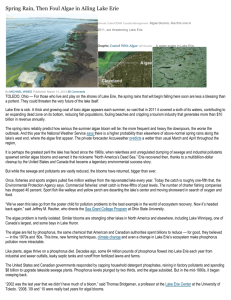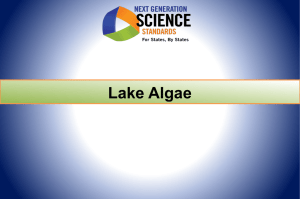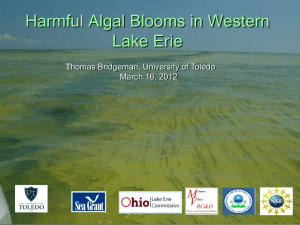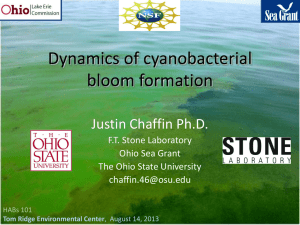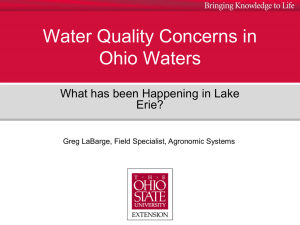alge-new-york-times-algae-03-15-2013
advertisement
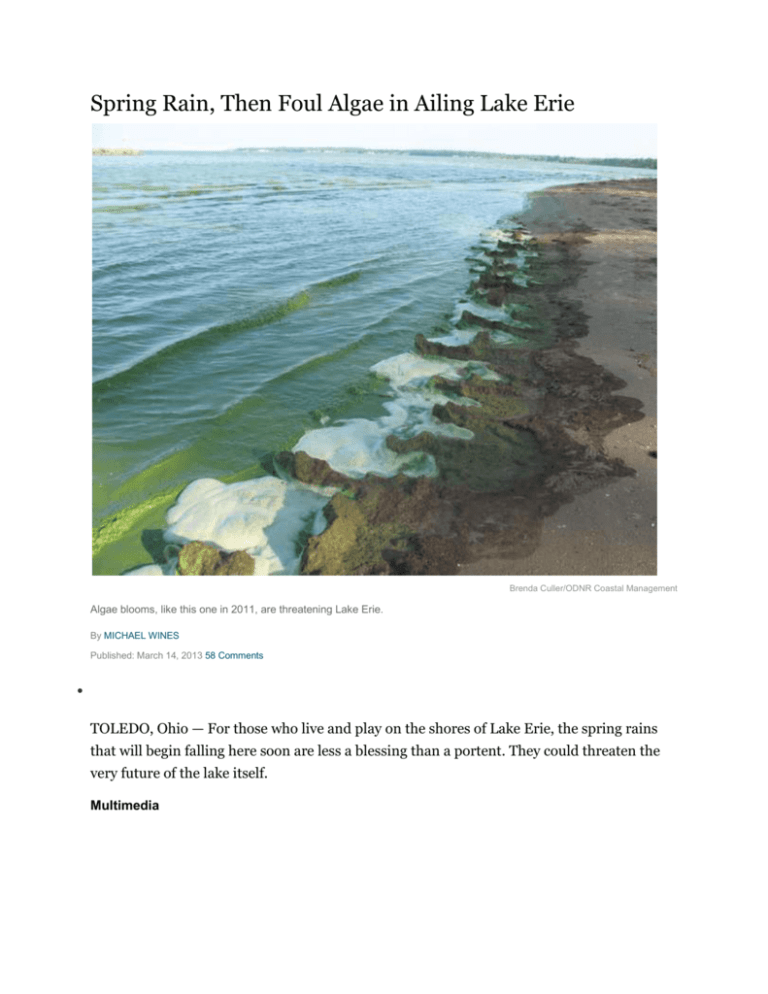
Spring Rain, Then Foul Algae in Ailing Lake Erie Brenda Culler/ODNR Coastal Management Algae blooms, like this one in 2011, are threatening Lake Erie. By MICHAEL WINES Published: March 14, 2013 58 Comments TOLEDO, Ohio — For those who live and play on the shores of Lake Erie, the spring rains that will begin falling here soon are less a blessing than a portent. They could threaten the very future of the lake itself. Multimedia Graphic Coated With Algae Enlarge This Image Jeff Reutter A water snake in Lake Erie. Readers’ Comments Share your thoughts. Post a Comment » Read All Comments (58) » Lake Erie is sick. A thick and growing coat of toxic algae appears each summer, so vast that in 2011 it covered a sixth of its waters, contributing to an expanding dead zone on its bottom, reducing fish populations, fouling beaches and crippling a tourism industry that generates more than $10 billion in revenue annually. The spring rains reliably predict how serious the summer algae bloom will be: the more frequent and heavy the downpours, the worse the outbreak. And this year the National Weather Service says there is a higher probability than elsewhere of above-normal spring rains along the lake’s west end, where the algae first appear. The private forecaster Accuweather predicts a wetter than usual March and April throughout the region. It is perhaps the greatest peril the lake has faced since the 1960s, when relentless and unregulated dumping of sewage and industrial pollutants spawned similar algae blooms and earned it the nickname “North America’s Dead Sea.” Erie recovered then, thanks to a multibillion-dollar cleanup by the United States and Canada that became a legendary environmental success story. But while the sewage and pollutants are vastly reduced, the blooms have returned, bigger than ever. Once, fisheries and sports anglers pulled five million walleye from the rejuvenated lake every year. Today the catch is roughly one-fifth that, the Environmental Protection Agency says. Commercial fisheries’ smelt catch is three-fifths of past levels. The number of charter fishing companies has dropped 40 percent. Sport fish like walleye and yellow perch are deserting the lake’s center and moving shoreward in search of oxygen and food. “We’ve seen this lake go from the poster child for pollution problems to the best example in the world of ecosystem recovery. Now it’s headed back again,” said Jeffrey M. Reutter, who directs the Sea Grant College Program at Ohio State University. The algae problem is hardly isolated. Similar blooms are strangling other lakes in North America and elsewhere, including Lake Winnipeg, one of Canada’s largest, and some bays in Lake Huron. The algae are fed by phosphorus, the same chemical that American and Canadian authorities spent billions to reduce — for good, they believed — in the 1970s and ‘80s. This time, new farming techniques, climate change and even a change in Lake Erie’s ecosystem make phosphorus pollution more intractable. Like plants, algae thrive on a phosphorus diet. Decades ago, some 64 million pounds of phosphorus flowed into Lake Erie each year from industrial and sewer outfalls, leaky septic tanks and runoff from fertilized lawns and farms. The United States and Canadian governments responded by capping household detergent phosphates, reining in factory pollutants and spending $8 billion to upgrade lakeside sewage plants. Phosphorus levels plunged by two thirds, and the algae subsided. But in the mid-1990s, it began creeping back. “2002 was the last year that we didn’t have much of a bloom,” said Thomas Bridgeman, a professor at the Lake Erie Center at the University of Toledo. “2008, ’09 and ’10 were really bad years for algal blooms. “And then we got 2011.” 2011 was the wettest spring on record. That summer’s algae bloom, mostly poisonous bluegreen algae called Microcystis, sprawled nearly 120 miles, from Toledo to past Cleveland. It produced lake-water concentrations of microcystin, a liver toxin, that were 1,200 times World Health Organization limits, tainting the drinking water for 2.8 million consumers. Dead algae sink to the lake bed, where bacteria that decompose the algae consume most of the oxygen. In central Lake Erie, a dead zone now covers up to a third of the entire lake bottom in bad years. “The fact that it’s bigger and longer in duration is a bad thing,” said Peter Richards, a senior research scientist at the National Center for Water Quality Research at Heidelberg University in Ohio. “Fish that like to live in cold bottom waters have to move up in the thermocline, where it’s too warm for them. They get eaten, and that tends to decrease the growth rates of a lot of the fish.” Last spring, the rains arrived amid a record drought, and the algae retreated to waters near Toledo. “We had two extremes in two years,” Mr. Bridgeman said. “The lake responded exactly the way we thought it would.” But no one hopes for a drought. To cut phosphorus levels this time, scientists say, the habits — and the expensive equipment — of 70,000 farmers along the Erie shore must change. Most of the phosphorus that feeds algae these days comes from farmland. Much of the phosphorus originates near Toledo, where the Maumee River completes a 137mile journey and empties into the lake’s shallow western basin. Spring Rain, Then Foul Algae in Ailing Lake Erie Published: March 14, 2013 58 Comments Facebook Twitter Google+ Save E-mail Share Print Single Page Reprints (Page 2 of 2) The Maumee watershed is Ohio’s breadbasket, two-thirds farmland, mostly corn and soybeans. Farming there is changing radically, said Steve Davis, a watershed specialist with the United States Agriculture Department’s Natural Resource Conservation Service. Enlarge This Image Dr. Tom Bridgeman Tom Bridgeman, a professor at the University of Toledo, stood deep in deposits of algae, whose growth is encouraged by the runoff of agricultural fertilizers. Multimedia Graphic Coated With Algae Connect With Us on Social Media @nytimesscience on Twitter. Environment Reporters on Twitter Like the science desk on Facebook. Enlarge This Image Brenda Culler/ODNR Coastal Management Algae blooms in Lake Erie. Readers’ Comments Share your thoughts. Post a Comment » Read All Comments (58) » Plowing is declining; 55 percent of farmland is planted using anti-erosion methods promoted by the Resource Conservation Service, like no-till farming, in which seeds are inserted into small holes in unplowed ground. Fertilizing is now contracted to companies that cast pellets onto the bare ground from trucks, or to “factory farms” that spray liquefied animal waste on their cropland. Mr. Davis has analyzed his watershed almost to the last cornstalk. Animal waste makes up 14 percent of all fertilizer. The rest is fertilizer pellets, 48 pounds per acre. In past days, most pellets sank into plowed soil and stayed there. Now, rain and snowmelt wash an average 1.1 of those 48 pounds off unplowed soil. Much winds up in the Maumee, then in Lake Erie. The Maumee supplies only about 5 percent of Erie’s water, but half its phosphorus. And while algae struggle to digest ordinary phosphorus — only about 30 percent gets taken up — fertilizer phosphorus is designed for plants to use instantly. Two other recent changes make matters still worse. One is the zebra mussel, a foreign invader that has dominated Erie since its discovery in 1988. Millions of mussels feast on nontoxic green algae, removing competitors to the toxic Microcystis algae and decimating the base of the food chain that supports Erie’s fish. Then in a vicious cycle, mussels excrete the algae’s phosphorus, providing the Microcystis a readymade meal. The other is climate change. Only heavy rains wash fertilizer off farmland, and since 1940, Mr. Richards said, heavy spring rainstorms have increased by 13 percent. The Maumee’s phosphorus can be limited, Mr. Davis says, but only if farmers change their approach. More soil testing and new G.P.S.-guided machinery can ensure that crops receive the minimum fertilizer they need. Other new equipment can put fertilizer in the ground during planting instead of pellets being broadcast in the winter. Leaving land fallow beside streams reduces runoff. The catch is that fertilizing is already efficient: that wasted 1.1 pounds is but 2 percent of all pellets spread on Maumee-area farms. “When you’re only losing a pound per acre,” Mr. Davis said, “how do you cut it to a half?”
